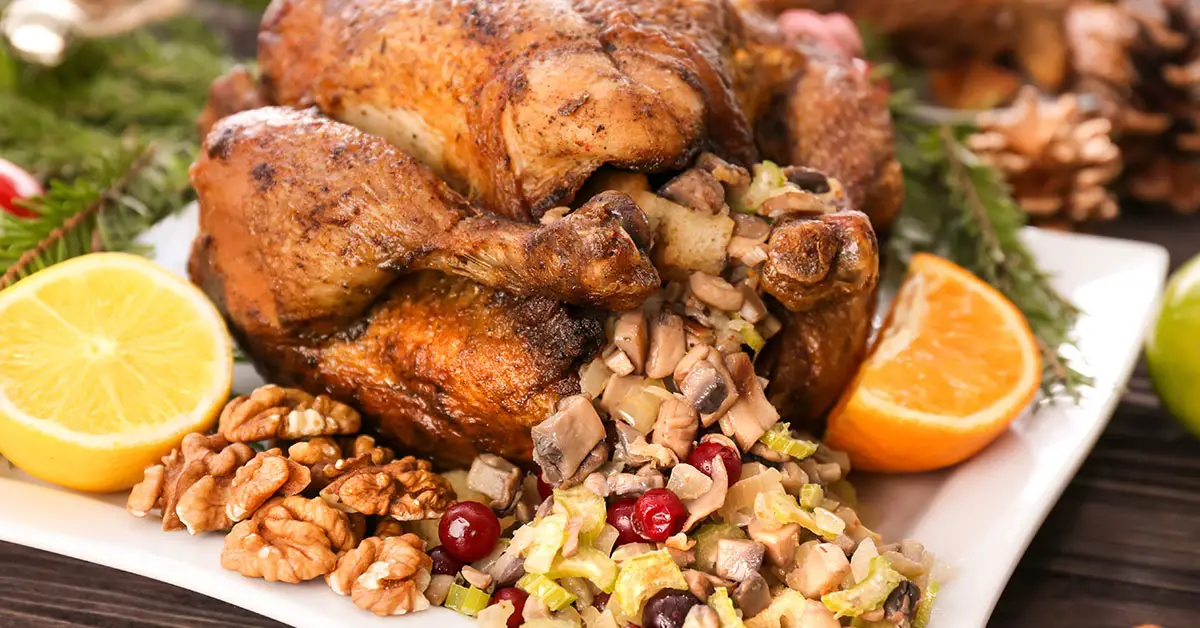Thanksgiving is a day for family and gratitude. And of course, the iconic and delicious Thanksgiving dinner, which includes a large roast turkey with gravy and cranberry sauce, mashed potatoes, sweet potatoes, pumpkin pie, pecan pie, green beans, Brussel sprouts, and of course, stuffing. However, this dish raises an important safety consideration. Is it safe to cook stuffing inside the turkey? Here are some tips on how to prepare a safe and delicious Thanksgiving dinner.
Should You Put Stuffing in Turkey?
The handling — or rather, mishandling — of raw poultry and undercooking it are the common issues that cause foodborne disease. Therefore, putting stuffing in an undercooked turkey could potentially contaminate the dish. However, this method can add a lot of flavor to the stuffing, which is why many people choose to cook it this way. But here’s to ensure it stays safe.
First off, put the stuffing in the turkey just before cooking it. Don’t stuff the bird in advance. Secondly, use a food thermometer to ensure the center of the stuffing has reached 165 degrees Fahrenheit. That temperature can kill the bacteria that cause food poisoning. And lastly, after taking the turkey out of the oven, wait 20 minutes before removing the stuffing to allow it to cook more.
In short, the key to safe and healthy stuffing is the safe and healthy handling of the turkey. Here are some tips for handling the centerpiece of the Thanksgiving meal:
Step 1: Properly thaw the turkey.
To do this, either 1) place the frozen turkey in a sealed container in the refrigerator, 2) put it into a leak-proof plastic bag in a sink or tub of cold water, changing the water every half an hour, or 3) thaw it in the microwave according to the manufacturer’s instructions. Do not thaw the bird by leaving it on the counter. This leaves the turkey in what is known as the “danger zone,” which are temperatures between 40 and 140 degrees Fahrenheit. Within this range, bacteria can double every 20 minutes potentially reaching harmful levels [1].
Read: Handy Chart Shows You How Long You Can Freeze Different Foods
Step 2: Don’t wash or rinse the raw turkey.
Many family traditions preparing this dish involve rinsing the bird. However, federal food safety guides have recommended against it since 2005. After all, this could spread the bacteria in the poultry to the countertops and utensils, and possibly other foods. You don’t need to wash the turkey; the high temperatures in the oven will do the job for you.
“The problem with this practice is that pathogenic bacteria often are embedded in the surface of the skin,” said Martin Bucknavage, food safety specialist in the department of food science. “When faucet water hits bacterial pathogens, they become aerosolized and land all over your kitchen counter, the faucet, and you.
“The U.S. Food and Drug Administration says Campylobacter is one of the most common causes of diarrheal illness in the country, and undoubtedly, many of these cases are a result of cross-contamination in the kitchen. So there is no need to wash the outside of your bird — the cooking process easily will kill these bacteria. But you still need to clean and sanitize your counter and any kitchen equipment that touches the raw bird.” [2]
Step 3: Handle the turkey safely.
Speaking of how rinsing could spread bacteria, ensure that all over handlings of the turkey are safe as well. Here is how: Use a separate cutting board for slicing the raw poultry. Additionally, whatever utensils — including plates, knives, countertop, or cutting board — should be washed thoroughly with hot soapy water before being used for other food preparation. Plus, you should wash your own hands before and after handling the turkey with hot soapy water for 20 seconds.
Read: Sparkling Red Native American Corn Saved from Extinction By Moonshiners
Step 4: Cook the stuffing thoroughly.
As mentioned before, it’s imperative to stuff the bird right before cooking it. Then use a food thermometer to ensure the stuffing reaches 165 degrees Fahrenheit. Additionally, don’t forget to wait 20 minutes after cooking to let the stuffing cook longer before removing it. While you’re at it, be careful not to over-stuff the bird; instead, loosely put the stuffing into the bird will give more room to cook properly without forcing you to overcook the turkey.
“It is the undercooked stuffing that poses the real risk,” said Bucknavage. “Bacterial pathogens such as Salmonella may be present in the cavity of the bird and can contaminate the stuffing. If the stuffing is not cooked thoroughly, Salmonella can survive and may infect those who consume it.”
Step 5: Cook the turkey thoroughly.
For proper cooking, ensure the oven is set to at least 325 degrees Fahrenheit. When the turkey is completely thawed, place it into a deep roasting pan. The exact cooking time depends on the size and weight of the bird. A food thermometer is super helpful to ensure the poultry is fully cooked.
For some people, the risk of bacteria and over-cooked turkey isn’t worth it and they’d prefer to cook the turkey and the stuffing separately. Either way, the Thanksgiving meal is bound to be delicious, you just have to prepare it safely! [3]
Keep Reading: How Getting into the Christmas Spirit Early Affects Your Mental Health
Sources
- “Food Safety Tips for Holiday Turkey.” CDC. May 5, 2021
- “Stuffing the turkey and other Thanksgiving food-safety mistakes.” Medical Xpress. Pennsylvania State University. November 25, 2009
- “Cooking Stuffing Inside a Turkey Is Actually Dangerous—What You Need to Know.” Self. Audrey Bruno. November 23, 2016

